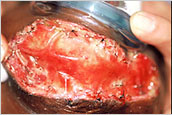| Inspection and Care
of Neodermis |
|


During the early stages of Neodermis development
take note of the following:
- If elastic net dressing was used,
leave in place and do not remove staples or sutures

- Take down all dressings to the elastic
net layer to inspect INTEGRA® Template sites, seams,
and edges for evidence of hematomas, fluid accumulation,
infection/purulence, premature silicone layer separation,
and areas of non-take. Inspection may be performed through
interstices of elastic net dressing (do not remove unless
necessary).

- Re-moisten antimicrobial dressings
after INTEGRA® Template inspection. Irrigation tubing
can be used to re-moisten or re-apply without removing
dressings.

- Re-moisten or re-apply antimicrobial
dressing as needed, typically every twelve hours, or
more often for dry climates

- Replace or change new antimicrobial
dressing at least every three days

- During week 2, change dressings every
other day. In week 3, dressings should be changed
every third day.
When removing dressings to inspect INTEGRA® Template sites, care should be taken to avoid dislodgement.
As you gain experience with INTEGRA® Template, your
frequency of inspection
and dressing changes is likely to change from this schedule.
Movement / Outpatient Care
As shearing will result in the NON-TAKE of INTEGRA® Template, the
goal for the staff and patient is to minimize these forces
on the INTEGRA® Template site. Bolsters, splints and Ace
Wrap compression (an important outer dressing during the
first 24-48 hours) will help protect from friction and
shear of INTEGRA® Template from the excised bed.